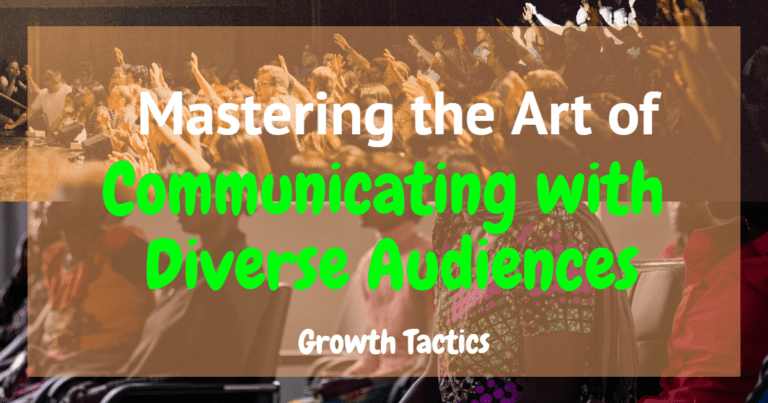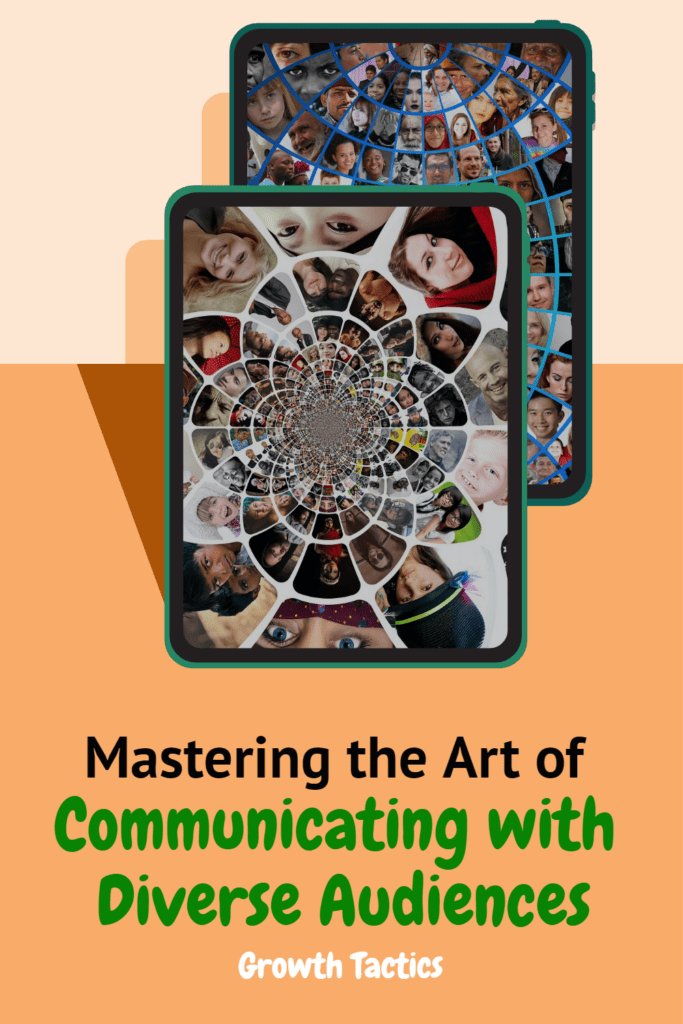In today’s globalized world, communicating with diverse audiences has become an essential skill for everyone. Given the varied backgrounds, experiences, cultures, and languages of individuals and groups, communicating effectively requires more than just linguistic competence. It demands inclusivity, respect, understanding, and creativity. This blog post will explore the art of communicating with diverse audiences and offer practical tips on how to master it.
Jump To Section
Understanding Diversity and Inclusion
To communicate effectively with diverse audiences, one must first understand the importance of diversity and inclusion. Diversity refers to the differences among people, such as race, ethnicity, gender, age, religion, disability, and sexual orientation, while inclusion implies creating a welcoming environment that respects and values these differences. A decisive step in mastering communication with diverse audiences is to acknowledge and respect these differences and recognize their positive impact on society.
Tips on How to Communicate with Diverse Audiences
Following these tips on how to communicate with diverse audiences can significantly enhance your ability to communicate effectively. Some of the tips you can consider include:
Acknowledge Different Cultural Perspectives
When communicating with diverse audiences, it is important to recognize and acknowledge that individuals from different cultures may have distinct perspectives and ways of seeing the world. Acknowledging these different cultural perspectives is crucial in fostering a sense of understanding and inclusion. It demonstrates respect for diversity and allows for meaningful connections to be formed.
To acknowledge different cultural perspectives, it is essential to be attentive and open-minded. Take the time to actively listen and understand how others view the world based on their cultural backgrounds and experiences. This includes being aware of cultural norms, values, and traditions that may influence the way individuals interpret and respond to information.
By acknowledging different cultural perspectives, you can tailor your communication to be more culturally sensitive and appropriate. This can help ensure that your message resonates with diverse audiences and avoids potential misunderstandings or misinterpretations.
Ask Questions
One of the most effective ways to communicate with diverse audiences is by asking questions. Asking open-ended questions can help you gain insight into your audience’s preferences, cultural background, or experiences. It also demonstrates that you recognize and value their perspective.
When asking questions, it is important to create a safe and inclusive space for individuals to share their thoughts and experiences. Encourage open dialogue and actively listen to the responses you receive. This not only promotes understanding but also shows respect for diverse voices and experiences.
By asking questions, you can uncover valuable insights that may inform your communication approach. Understanding your audience’s needs, expectations, and cultural context can help you tailor your message in a way that resonates with them. It also promotes a sense of inclusivity and engagement, fostering meaningful connections with diverse audiences.
Avoid Jargon and Technical Terms
To effectively communicate with diverse audiences, it is crucial to avoid jargon and technical terms that may be unfamiliar or confusing to non-experts. Jargon refers to specialized language or terminology in a particular field or industry. While it may be second nature to use such language within your professional or academic circles, it can create a barrier for those who are not familiar with it.
Using language that is clear, concise, and easily understandable across cultures helps ensure that your message reaches and resonates with diverse audiences. It is important to choose words and phrases that are widely accessible and do not exclude or confuse individuals with different levels of knowledge or expertise.
By avoiding jargon and technical terms, you create a level playing field for communication. This allows all individuals, regardless of their background or experience, to fully understand and engage with your message. It promotes inclusivity, making your communication more effective and impactful.
Be Courteous and Respectful
Being courteous and respectful is essential when communicating with diverse audiences. It shows that you recognize and appreciate their differences, and respect their perspective and experiences. Treating others with courtesy and respect creates a positive atmosphere that encourages feedback and communication.
To be courteous and respectful, use appropriate language and tone. Be mindful of your body language and cultural norms, such as eye contact, personal space, and non-verbal cues. Avoid making assumptions based on stereotypes or generalizations, and acknowledge different cultural perspectives. Listen actively to what others are saying, and respond in a polite and respectful manner.
By being courteous and respectful, you create an atmosphere of trust and mutual respect that encourages open communication. This fosters inclusivity and enhances the effectiveness of your message.
Know Your Audience
Knowing your audience is essential to communicating effectively with diverse groups. Understanding their cultural background, language proficiency, communication style, and preferences can make a significant difference in the way you deliver your message. To achieve this, consider getting to know your audience or conducting research beforehand. You can also ask questions to gauge their expectations and preferred communication styles.
Avoid making assumptions based on stereotypes, generalizations, or preconceived notions. Recognize the diversity within the group, and tailor your message to reflect the needs and preferences of each individual. Being aware of cultural differences and nuances can help you avoid misunderstandings and promote inclusivity.
By knowing your audience, you create a connection with them and show that you value their perspective. This enhances the effectiveness of your message and fosters engagement and collaboration.
Use Inclusive Language
Using inclusive language is essential in communicating with diverse audiences successfully. It refers to language that is non-discriminatory and avoids marginalizing any particular group or individual. For instance, using gender-neutral language by avoiding or rephrasing gender-specific terms like “he” or “she,” can make a difference in how your message is perceived.
It is important to be mindful of your language and avoid using language that can create unintended barriers or exclusion. This includes avoiding ableist language, slang, or jargon that may not be familiar to all individuals.
Using inclusive language promotes a sense of belonging and fosters inclusivity. It shows that you value diversity and recognize the importance of respecting and including everyone.
Improve Your Communication Skills
Improving your communication skills is crucial for effective communication with diverse groups. Here are some strategies to enhance your communication abilities:
Clarity and Brevity: Clearly and concisely convey your message, making it easy for diverse audiences to understand. Use simple and straightforward language, avoiding complex jargon or technical terms. Break down information into smaller, digestible parts, and ensure your message is organized and logical.
Active Listening: Actively listen to your audience and show genuine interest in their perspective. This involves giving your full attention, maintaining eye contact, and providing non-verbal cues to demonstrate engagement. Paraphrase and summarize to confirm understanding, and ask clarifying questions when necessary.
Adaptability: Adapt your communication style to suit different audiences. Be mindful of cultural norms, values, and communication preferences to ensure your message is received positively. For instance, some cultures may value indirect communication or have different expectations for personal space.
Visual Aids: Use visual aids, such as images, charts, or videos, to enhance understanding and engagement. Visuals can effectively convey information and transcend language barriers. Ensure your visuals are culturally appropriate and accessible to all members of your audience.
Avoid Biases
Avoiding biases is crucial for effective communication with diverse audiences. Unconscious or conscious biases can alienate your audience or create misunderstandings. Here are some strategies to help you avoid biases:
Self-awareness: Develop self-awareness about your own biases. Reflect on your beliefs, assumptions, and attitudes, and challenge any biases that may influence your communication. Be open to learning from others and questioning your own perspectives.
Cultural sensitivity: Be mindful of cultural differences and avoid making assumptions based on stereotypes. Recognize and respect diverse perspectives and experiences. Be open to different ways of thinking and communicating.
Avoid figurative language and idioms: Figurative language and idioms can create confusion or exclusion for individuals who are not familiar with them. Opt for literal and clear language to ensure your message is understood by a diverse audience.
Non-Verbal Communication
Non-verbal communication plays a significant role in effective communication with diverse audiences. Paying attention to non-verbal cues can help you better understand the message being conveyed and establish rapport. Here are some key aspects to consider:
Facial Expressions: Facial expressions are universal indicators of emotions. A smile can convey warmth and friendliness, while a furrowed brow can indicate confusion or concern. Be aware of the cultural variations in interpreting facial expressions, as certain gestures may have different meanings in different cultures.
Gestures: Gestures, such as hand movements or body postures, can add emphasis or clarify meaning in communication. However, it’s important to recognize that gestures can also vary across cultures. For example, the “thumbs up” gesture may be seen as positive in some cultures but offensive in others. Be conscious of the cultural appropriateness of gestures to avoid misunderstandings.
Body Language: Pay attention to your own body language and how it may be perceived by different audiences. Maintain an open and welcoming stance, avoid crossing your arms, and make appropriate eye contact. Adapt your body language to align with the cultural norms of your audience to establish trust and understanding.
Seek Feedback and Clarification
Seeking feedback and clarification is crucial in effective communication with diverse audiences. By actively encouraging open dialogue and inviting feedback, you signal your commitment to understanding and ensure clear communication. Here are some ways to achieve this:
Open Communication: Foster an environment that encourages open dialogue and makes everyone feel comfortable sharing their thoughts and opinions. Emphasize the importance of diverse perspectives and encourage active participation from all members of your audience.
Ask for Feedback: Actively ask for feedback from your audience to gauge their understanding and engagement with your message. This feedback can highlight areas that require further clarification or adjustment. Demonstrating a willingness to receive feedback shows your commitment to continuous improvement and stronger communication.
Clarifying Questions: Don’t hesitate to ask clarifying questions if you are unsure about something or if you sense that your audience may have misunderstood a concept. Clarifying questions helps avoid misunderstandings and provides an opportunity to correct any communication gaps. This shows your dedication to ensuring clear and effective communication.
Conclusion
In conclusion, mastering the art of communicating with diverse audiences is an essential skill for today’s workforce. Understanding diversity and inclusion, knowing your audience, using inclusive language, improving your communication skills, avoiding biases, and discovering tips on communicating with diverse audiences are all crucial steps in achieving effective communication. By implementing these tips and continuously learning and adapting, one can enhance their ability to reach diverse audiences and foster mutual understanding.


